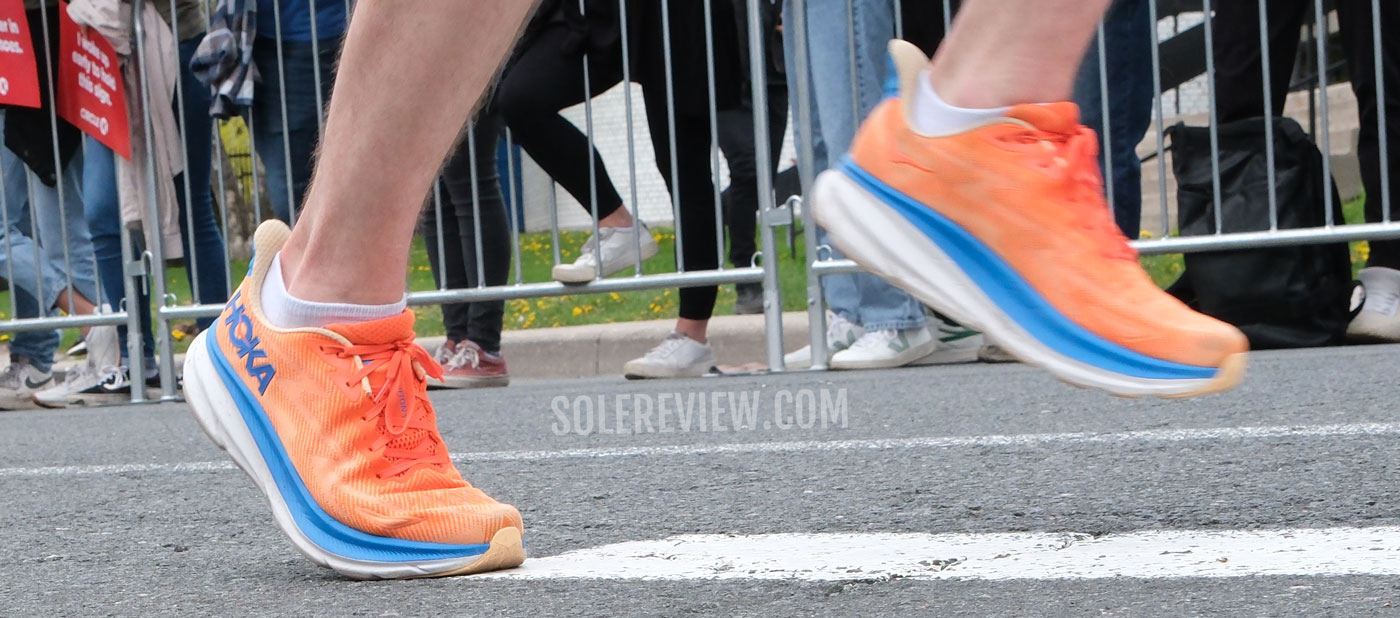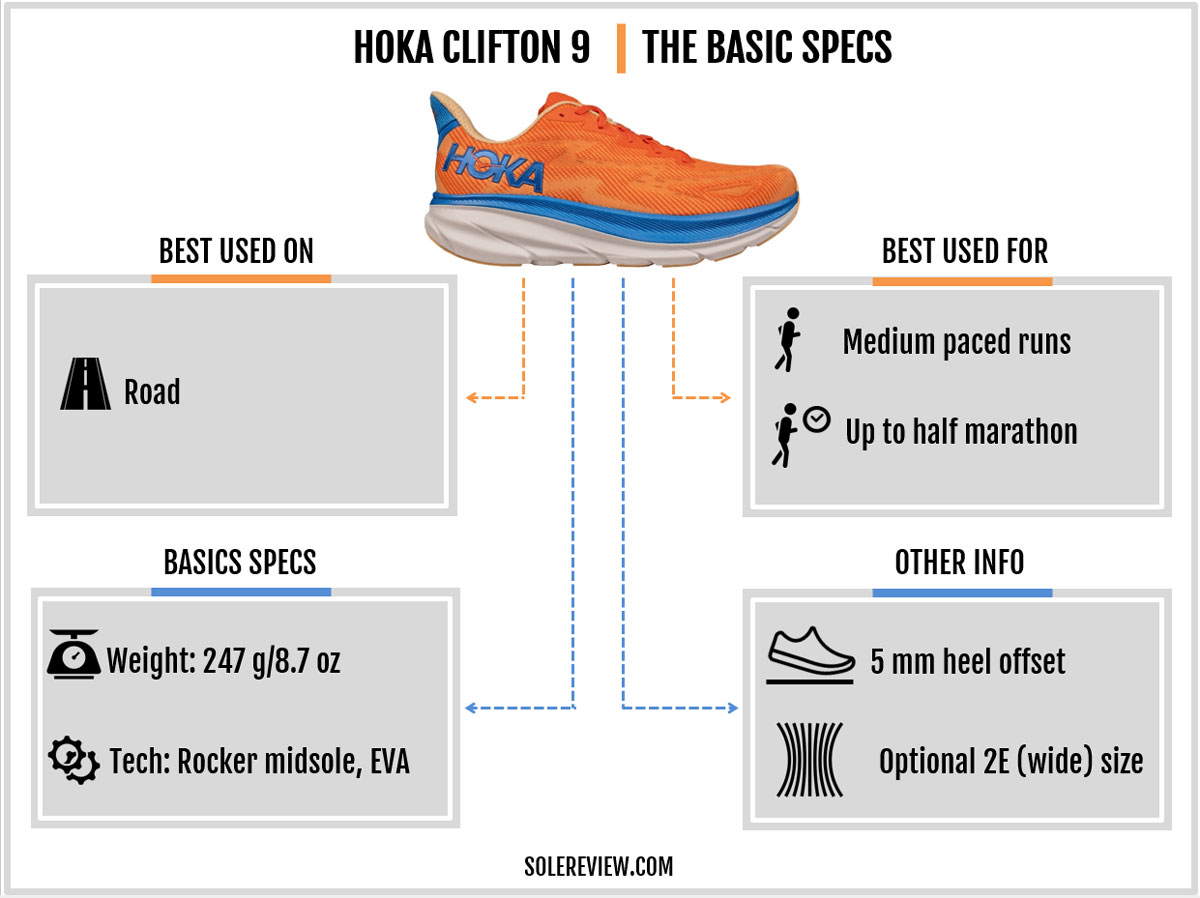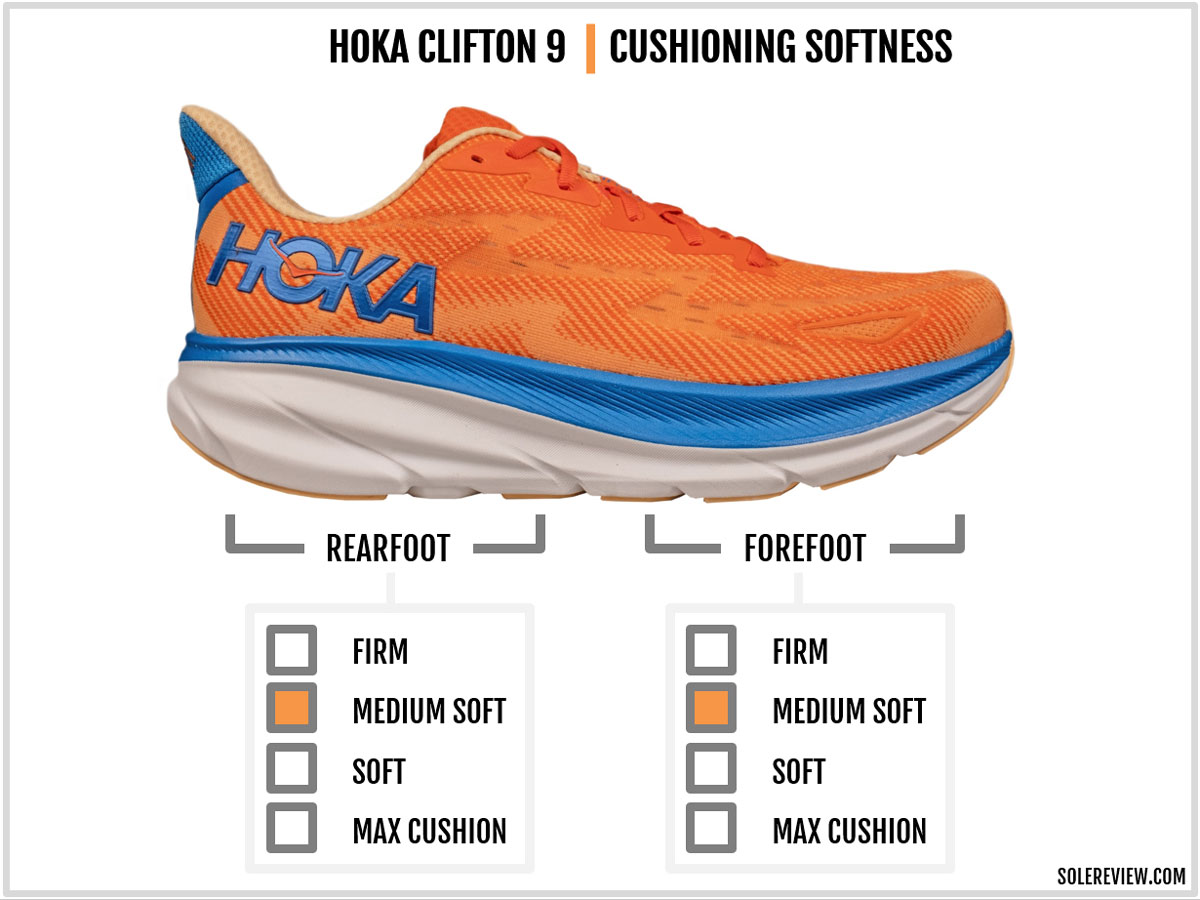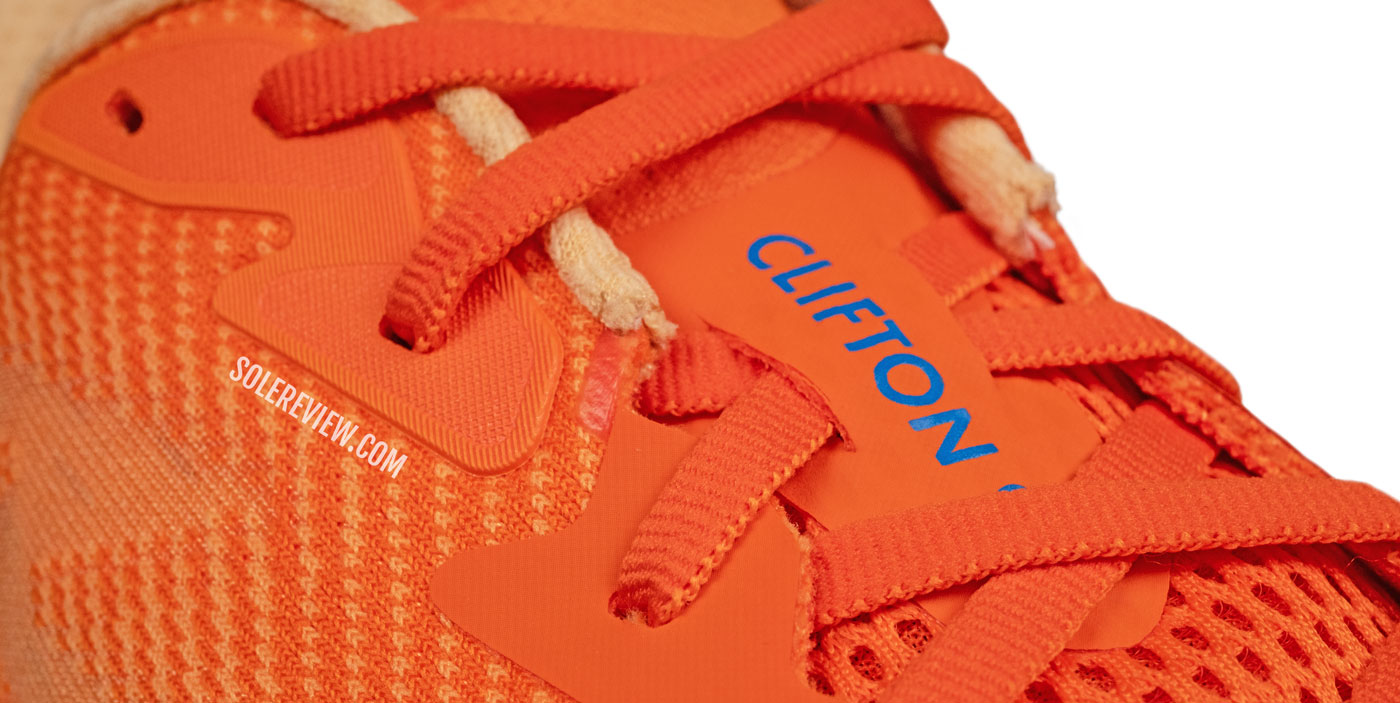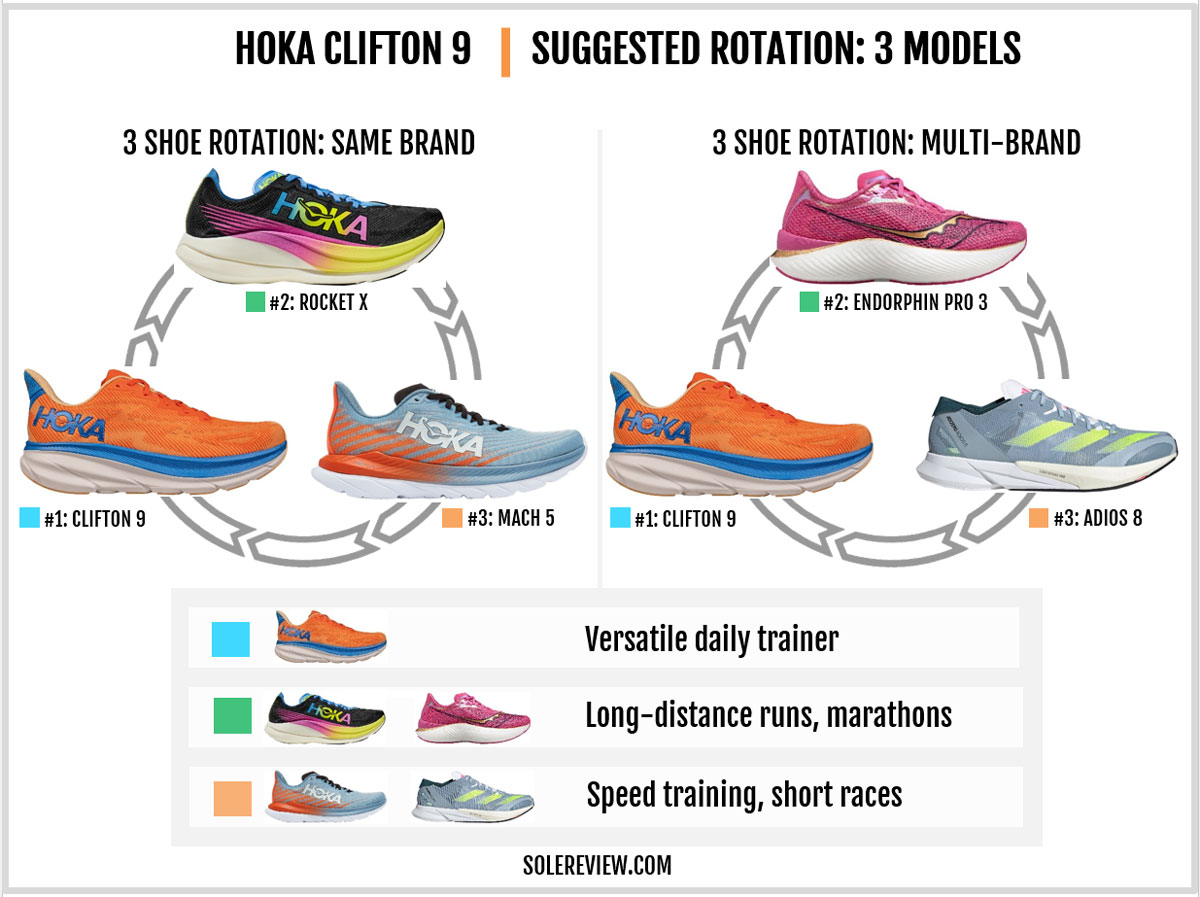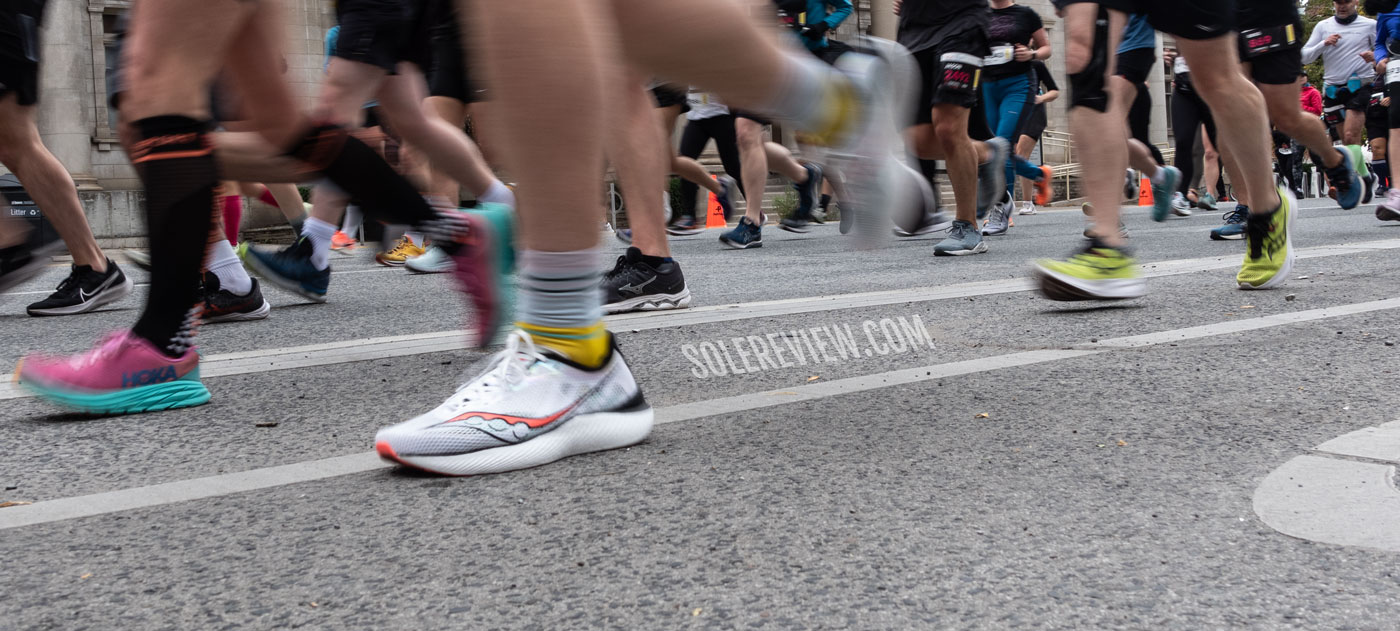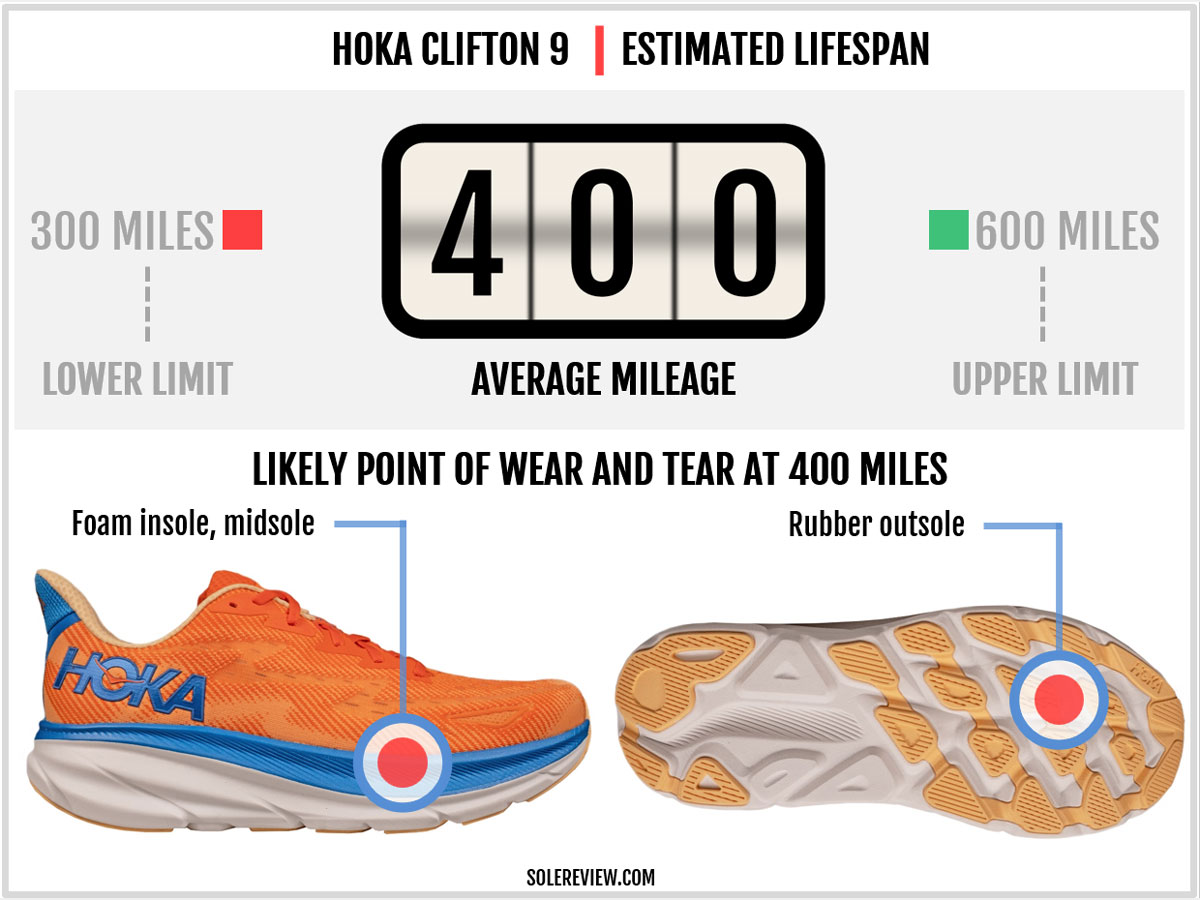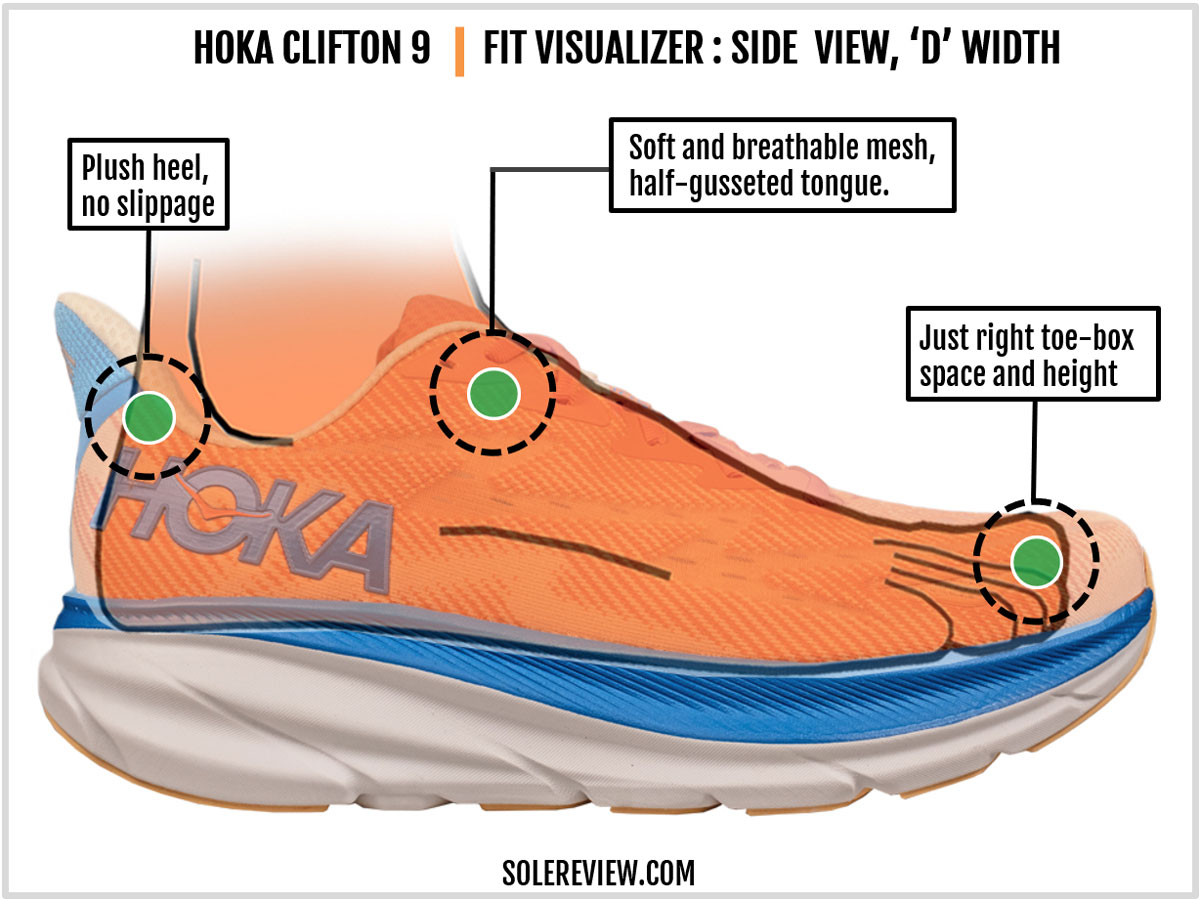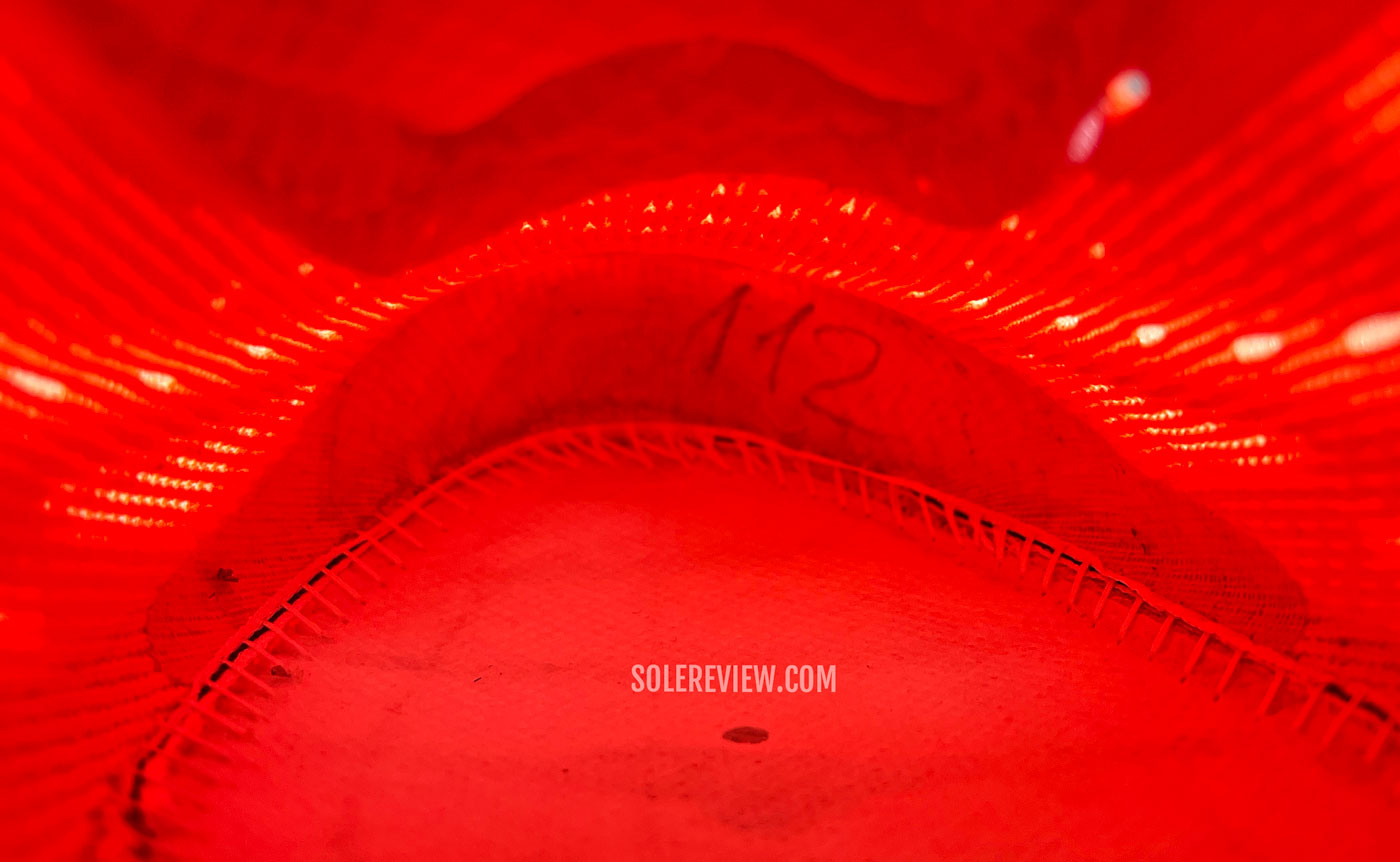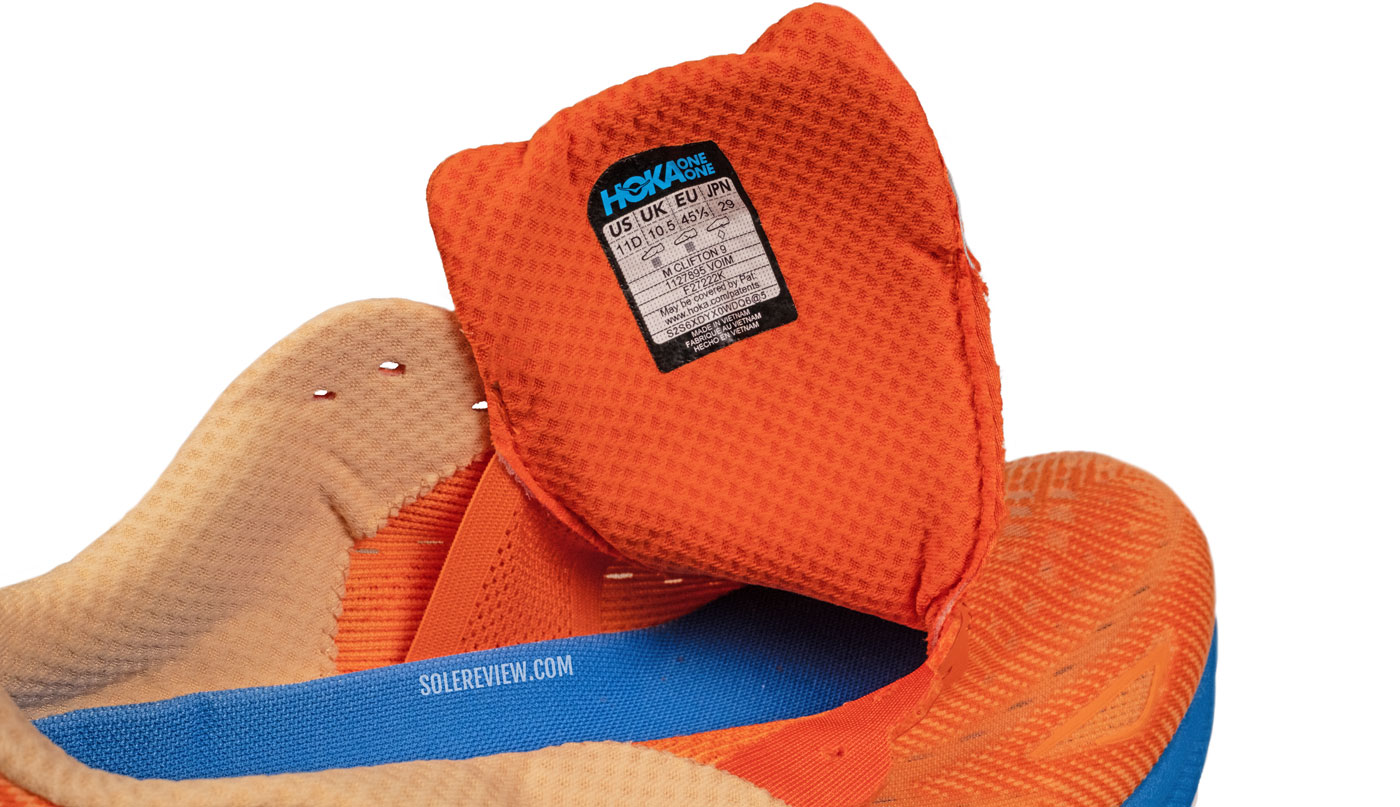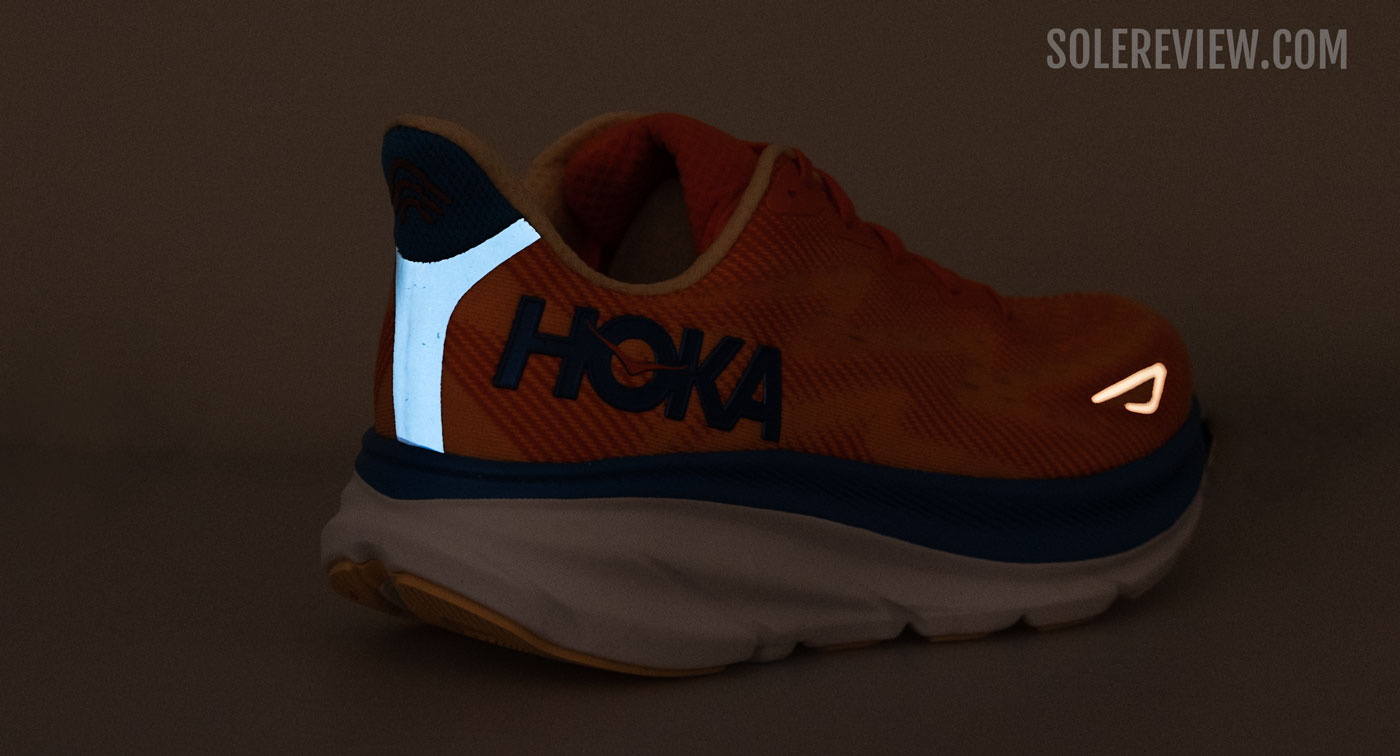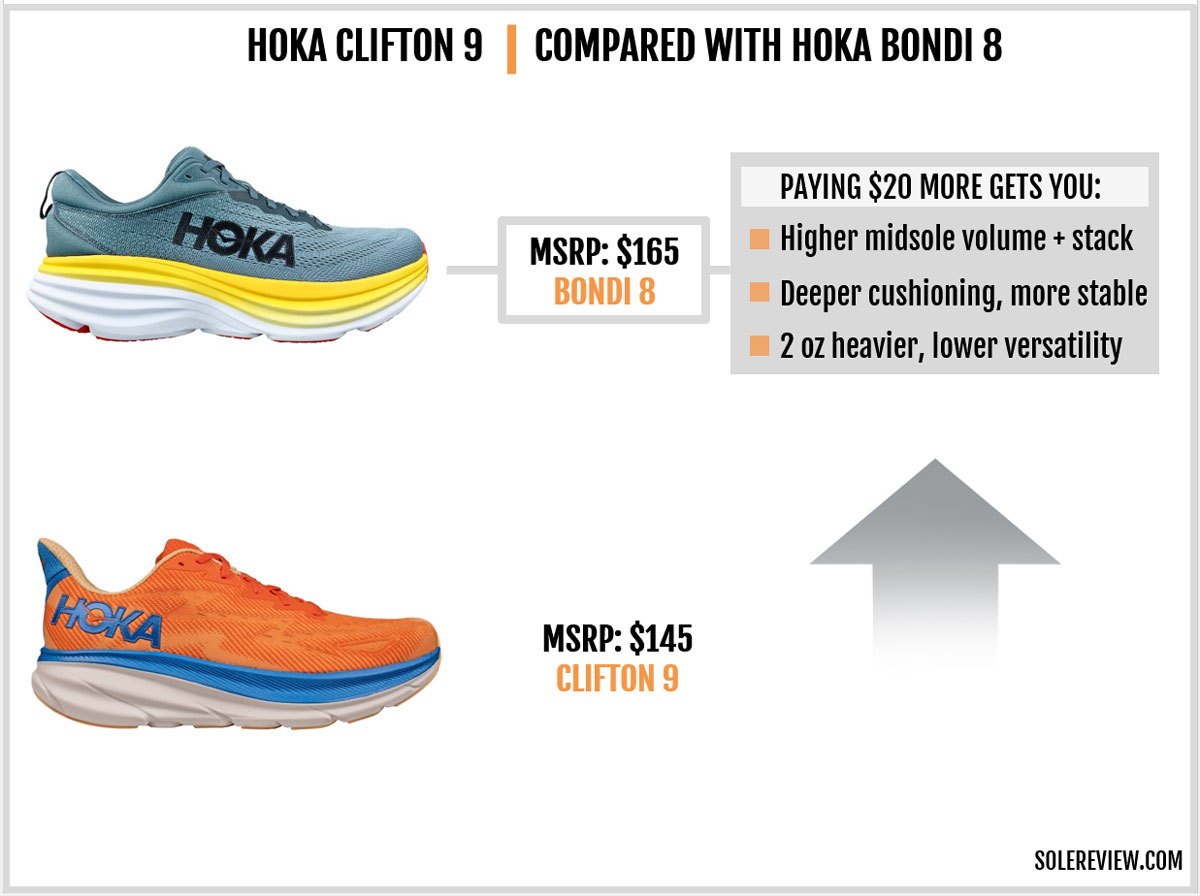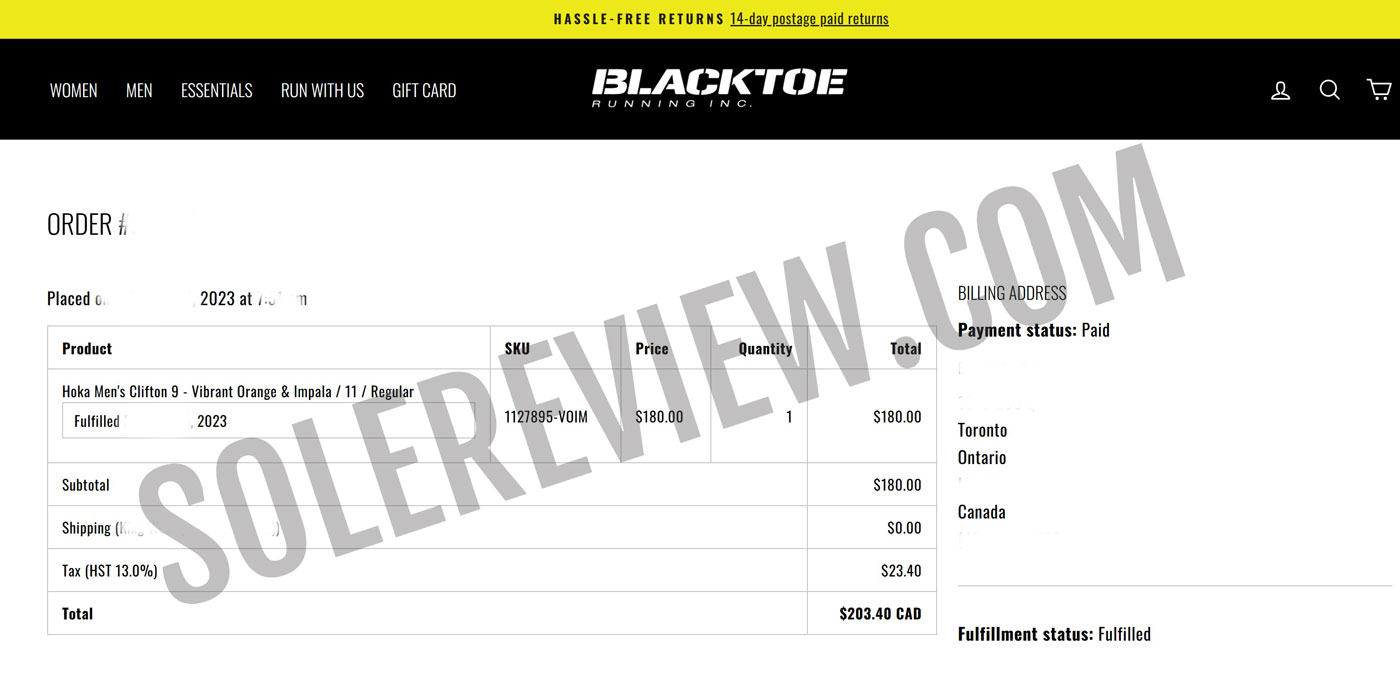
For this review, Solereview paid the full retail price for the Hoka Clifton 9. The amount is in Canadian Dollars.
In this review:
SUMMARY AND VERDICT
Once upon a time, the Hoka Clifton was a trendsetter of sorts. It led the trend that nudged the shoe industry towards high-stack midsoles with a rocker design.
The 2014 Clifton also had something that most other running shoes did not – the midsole used single-density foam without any inserts or cushioning ‘tech.’ Skechers is also owed some credit, as some of their popular shoes like the 2014 GoRun Ride brought rocker midsoles into the mainstream.
Back then, the Clifton’s appeal was its versatility. Where else could you find a running shoe with ample comfort for a long run, but wasn’t slow, heavy, or both?
Over the years, the Clifton hasn’t changed its formula or its ingredients. The building blocks of the Clifton 9 are similar to those used on the Clifton from nine years ago. There’s a thick EVA foam platform under a soft and ventilated upper. A rocker-shaped midsole offers the familiar roll forward before take-off.
And that’s what the Clifton 9 is. Familiar comfort. Not new, not exciting, but familiar. The Clifton hasn’t changed, but the world around it has.
However, it’s not the same each time. The upper has gone through a few passes of refinement, the ride experience is polished, and the price has gone up.
The Clifton is still a very popular shoe and a Hoka mainstay, because it does many things rather well. Also, there aren’t many direct competitors. The midsole cushioning is good enough for a marathon, and with all the versatility that everyday training deserves. While the Clifton 9 isn’t a great shoe for interval training, Fartlek, and tempo runs are manageable as long as the pace range is 4:30 min/km (7:00 min/mile) and slower.
In other words, the Clifton 9 gets the basics right. Except for the price, that is.
The 2020 Clifton 7 was $130, the Clifton 8 was $140, and the Clifton 9 retails at $145 without anything new to show for. That’s within kissing distance of $150, so the Clifton 9 isn’t great value at full price. Hoka is milking the Clifton for more than it’s worth. We’ll call it now; the Clifton 10 will most likely be a $150 shoe.
You can get more miles (and overall value) per dollar with shoes like the Saucony Triumph and Asics Nimbus, even if you have to pay $15 more.
But the good thing about the Clifton’s sameness is that you can get the Clifton 8 on sale, and you won’t be missing much.
THE HOKA CLIFTON 9 COMPARED WITH HOKA CLIFTON 8
Readers who have done some preliminary research would be aware of the Clifton 9’s increased midsole stack heights, so we’ll lead with that.
The Clifton 9’s midsole is taller by 3 mm, resulting in published stack heights of 40 mm (heel) and 35 mm (forefoot). The heel-to-toe drop is still 5 mm, as it was the last time.
At the same time, the Clifton 9 has a new footbed as well as a fabric lasting. The Clifton 9 doesn’t use an Ortholite insole or the perforated lasting from the Clifton 8; the new footbed has a smooth texture. The lasting is now fabric, and that means there are fewer layers of foam under the foot.
At the same time, the new midsole is thicker. These changes decreases the ‘step-in’s softness while increasing the cushioning depth below the midsole. That’s not all; there’s another change in how the midsole behaves.
The Clifton 8’s heel crash pad had a balanced design with a wide channel splitting the outsole into equal halves.
The Clifton 9’s hollow space isn’t as deep and is skewed towards the inner side. This gives the outer crash pad more freedom to splay during rearfoot landings. During runs, that translates into a softer heel-strike and a cushioning bias that favors the outer side. By the way, the Clifton 7 was also designed that way.
This makes the Clifton 9 less supportive than the Clifton 8. The difference won’t upset anyone, as it is barely noticeable. The thicker stack height also affects the stability. When fully loaded, the Clifton 9’s midsole is squished flatter than the Clifton 8 for the same bodyweight. Here are two pictures comparing the midsole behavior:

The Clifton 8’s midsole was harder to compress than the Clifton 9, and thus offered higher stability.
The outsole traction is another performance area where the Clifton 8 outperforms the current version. This is a bit odd, because the Clifton 9’s outsole uses more rubber. As it turns out, both the outsole lug texture and placement make a difference.
The Clifton 8’s outsole did a couple of things differently than the Clifton 9. The lugs had a distinct crisscross surface texture, and the entire forefoot had a flat profile. Most of the lugs were in contact with the running surface.
That’s not how the new outsole works; the Clifton 9’s lugs have a less defined texture. The forefoot outsole isn’t flat either, and has a raised – almost convex – profile.
The upper fits true-to-size and narrow as the last one. But there are changes. For example, the tongue sleeve is only one-sided and the tongue padding isn’t as plush as the Clifton 8. The heel padding lining has been swapped for a different mesh. Reflectivity is better this year, with the heel gaining a larger strip.
The Clifton 9 doesn’t feel as snug on top as the Clifton 8 did. The new Clifton breathes better due to the thinner mesh, redesigned tongue, and single-sided gusset.
Summing up, the Clifton 9 brings you a higher level of ride comfort with marginally lower stability. It’s also $5 more expensive than the Clifton 8.
THE MIDSOLE DESIGN AND RIDE EXPERIENCE
A 3 mm taller midsole makes some difference to the ride experience, mainly to the ride comfort and stability. But in the grand scheme of things, it’s insignificant. Running in the Clifton 9 feels very familiar, as it’s based on a similar form factor as the last eight Cliftons.
The cushioning is derived from a compression-molded (find out more) midsole with a high toe spring, which is commonly known as a ‘rocker’ shape. With a heel stack height of 40 mm, the Clifton 9 is the tallest it’s ever been. The foam density has a medium softness that doesn’t fully collapse when loaded.
The Clifton 9 is relatively supportive for a running shoe with high stack heights. You won’t get the sure-footed stability of the Clifton 8 because of the changes, but the midsole doesn’t mess up your sense of balance. Except for the slight bias towards the outer side, the overall ride character is neutral. If you weigh over 80 kgs/176 lbs, loading the midsole results in noticeable compression. That said, the foam doesn’t bottom nor does it tilt inwards.
These simple ingredients make the Clifton the shoe it is. The EVA foam midsole comes through on the ride comfort for the duration of a run; it does okay even for a marathon.
Despite the lack of any high-tech components or foam, the Clifton does two things very well. Ramping up from a 6:00 min/km (9:40 min/mile) to a 4:30 min/km (7:00 min/mile) pace takes no effort on the part of the shoe. While intervals can be a bit of a push, Fartleks and tempo runs are within the Clifton’s performance boundaries.
Some cushioned shoes have a split-second inertia before successfully transitioning to a higher gear. That’s not the Clifton 9. There’s no lethargy in picking up speed, and it’s equally easy to slow down.
The Clifton 9 also does not feel lifeless, as do many running shoes with an EVA foam midsole. Notable examples would be the Saucony Ride 16, Saucony Endorphin Shift, and the Brooks Ghost.
The cushioning is not ‘responsive’ or ‘bouncy’. The Clifton does offer a nice roll-forward quality, and that’s par for running shoes with a rocker midsole. The forefoot is inflexible, and that makes it easier to tip over towards the end of the gait cycle.
Does the Clifton 9 require any break-in time? Yes, some. The midsole edges curve inwards under the arch, so it takes a few days (around 20 miles) for the components to bed in. Other than that, the Clifton 9 is ready for the road right out of the box.

For the first time in its existence, the Clifton does have not the perforated foam lasting. In its place is a mesh Strobel.
The Clifton 9’s taller midsole is a trade-off of sorts. The sensation of ‘step-in’ softness has diminished slightly because of the new lasting and insole. The Clifton 9 uses a new footbed as well as a tweaked lasting that is not foam. This is the first Clifton that does not use a perforated foam lasting. Obviously, these changes reduce the amount of ‘squish’ just under the foot.
The outsole traction isn’t great when the surface conditions are less than perfect. The Clifton 9 doesn’t grip very well on damp roads and sidewalks. If your running path includes moist wooden tiles or planks, be mindful of the foot placement.
Can the Clifton 9 be your one shoe for everything? It depends on what the definition of ‘everything’ is. Daily training is a great use case for the Clifton 9, and so is a half-marathon at speeds below 4:30 min/km (7:00 min/mile). The Clifton 9 does okay for tempo runs and Fartlek – it’s softer than before, so the more supportive Clifton 8 is a better choice for those workouts. Interval training is best left to low-profile lightweights like the Mach 5.
The 5 mm heel drop and beveled heel make the Clifton midfoot strike-friendly. The midsole has a broad footprint without a narrow waist, and that kind of design works well for full-contact landings.
In a way, what made the Clifton different from its peers in 2014 also works in 2023.
Except that EVA midsoles are passé and considered a base cushioning tech. The Clifton 9 is certainly not worth $145, and we don’t what Hoka was thinking.
Unless – there is a hypothetical Clifton 10 that uses a Saucony Triumph kind of midsole, and Hoka is preparing the public for the inevitable $150 price. If the V10 happens to be just another dressed-up EVA foam runner, then that might steer the public away from the Clifton. If the Clifton’s legacy had a price, $150 is $20 too much.
RECOMMENDED ROTATION
The Hoka Mach has gained a following over the years; while its long-term durability is questionable, its speed-friendly comfort isn’t. This lightweight trainer is more versatile than it appears on the surface.
The Hoka Mach 5 is as much a daily trainer as it is a road racer for up to 10K distances. If not the Kinvara, the adidas adios 8 would be our pick. It’s softer and wider-fitting than the adios 7, and is less punishing on the feet than before.
A plated marathon racer it might be, but the Hoka Rocket X-2 is a me-too product with a PEBA midsole and a Carbon plate, so why settle for anything less than the tried-and-tested Saucony Endorphin Pro 3? Or even the adidas adios Pro 3, if you want something firmer?
That way, the Clifton 9 adds rotational value with the Mach 5 and Saucony Endorphin Pro 3 as flankers.
IS THE HOKA CLIFTON 9 DURABLE?
The Clifton will last as long as most shoes with a partially exposed outsole do. Which is around 400 miles, give a take a 100.
An EVA foam midsole is inferior to modern cushioning materials like Saucony Pwrrun+ or adidas Boost/Lightstrike Pro, so it will compact over time; the EVA foam midsole also compresses a lot during the gait cycle.
The insole is usually the first to flatten, and that’s when runners complain about the ‘shoe losing its cushioning’. The midsole will acquire deep creases over time due to the repeated compression cycles.
The upper looks okay from a longevity perspective, as there are no weak zones near the midsole edge.
THE UPPER DESIGN AND FIT
In Hoka’s early days, most of its shoes were very tight with no optional widths in sight. That has changed for the better over the years, as Hoka uppers lost some of the snugness while improving the overall quality.
But Hoka running shoes still have a narrow fit relative to the competition. The stick length was never a concern, as the Clifton (among other Hoka products) fits true to size. A internal bumper creates room without making the toe-box pointy. Hoka sells a wide sizing too. For runners who live in a damp city, the waterproof Hoka Clifton 9 GTX will help keep the feet dry.
(Related: The best waterproof running shoes)
The lightweight mesh is good at circulating air, so the interior never feels suffocating. The slightly elastic laces and inner lining are soft to the touch, and there are no pressure hot spots.
The Clifton 8’s tongue was attached to a two-side gusset; the Clifton 9 only has a single-side attachment. It’s still effective in preventing tongue slide, so there’s no real loss.
Removing the outer gusset doesn’t affect the midfoot fit. If the Clifton 9’s midfoot fit feels different, that’s because the tongue is thinner with lighter padding. So the V9 feels less tighter on the top than the V8. The heel has a similar collar as the last time, except that the lining doesn’t use the smooth mesh from the V8.
Just like the previous model, the Clifton 9 is a very easy shoe to step into – the Achilles lip and stiff internal counter make that happen. The flared collar also doubles as a heel pull tab, should you so wish.
The Clifton 9 does a better job at providing low-light visibility than the past version. A large reflective strip on the heel is complemented with a couple of trims over the toe-box.
ORTHOTIC COMPATIBILITY
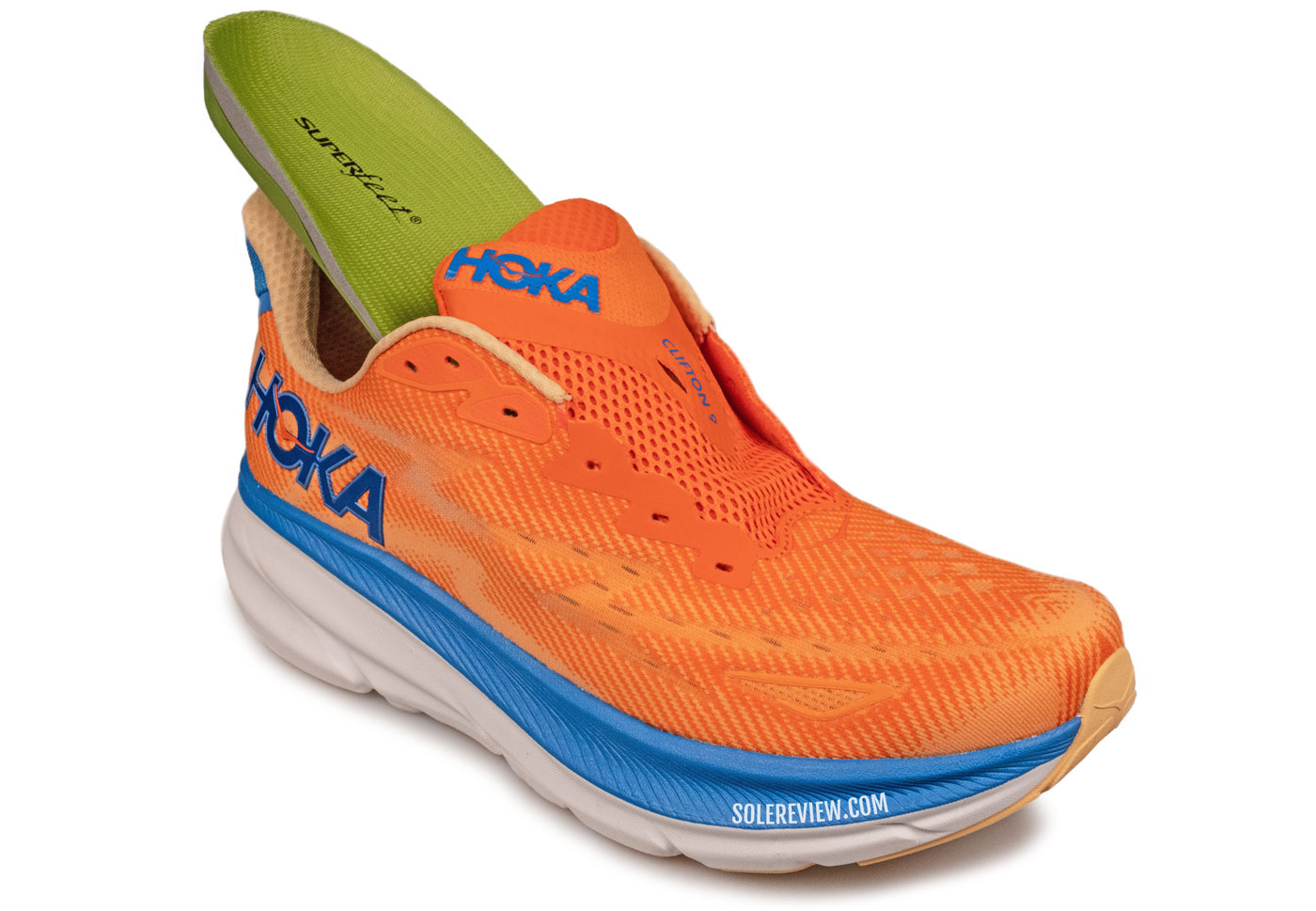
With a thin stock footbed, there’s a hard limit to what the Clifton can accommodate. You can try your luck with a Clifton wide, though.
Interior space is at a premium here, so if the thickness of the aftermarket insole exceeds that of the stock footbed, you’ll end up with a very tight Clifton.
Even the Superfeet will be a push here. If you want to use the Clifton with an orthotic, we suggest that you get the wide version. That’ll leave some margin for fit adjustment after replacing the stock insole.
PROS AND CONS
The Clifton 9 doesn’t have the pizzazz of a running shoe with super-foams and fiber components, but it’s an inoffensive crowd-pleaser.
While the EVA midsole lacks the bounce and excitement of newer foams, its ride comfort doesn’t feel dead. It’s engaging enough to not get bored during a half marathon. The rocker shape helps the Clifton’s case as a shoe for most occasions, intervals and fast races excluded.
The Clifton has sorted out most of its minor fit issues beginning with the V7, so the Clifton 9’s upper has no flaws worth mentioning. The shoe fits true to size and is smooth on the inside. The forefoot is snug, but far from unbearably tight. Other than the optional width, there’s even a waterproof GTX variant. The reflective trims aren’t a mere lip service, and prove useful in the dark.
There are two things we don’t like about the Clifton 9. The outsole grip is not as good as the Clifton 8, and the $145 sticker price is too much for the spec level.
COMPARISON: THE HOKA CLIFTON 9 VERSUS HOKA BONDI 8
The Bondi is one of Hoka’s most commercially successful shoes, because it sells the ‘max stack’ concept so well. The wide and tall midsole looks like a layered pastry, and is unlike any other shoe in the market.
But the cushioning isn’t the only thing that makes or breaks a shoe. The Bondi has a higher level of underfoot comfort over longer distances, but that also makes the ride lethargic when compared to the Clifton. The higher-volume midsole and 2-ounce heavier weight slows down the transition. We wrote about the Bondi 8 here.
To keep it short: The lighter Clifton 9 is a better ‘do everything’ shoe, whereas the Bondi 8 should be your shoe for more cushioning and a narrower fit.
SHOES COMPARABLE TO THE HOKA CLIFTON 9
It’s somewhat surprising that most other brands don’t have a direct Clifton competitor.
The shoe that’s closest to the Clifton is the Asics Novablast 3, a running shoe that uses a similar formula. Its Flytefoam midsole and rocker profile make it as versatile as the Clifton, and the narrow fit is also a close match. We don’t have miles on the Novablast 4 yet, so watch this space for updates.
And if you’re okay with spending an extra $35, then the Asics Superblast is a no-brainer.
We’ll also throw in the New Balance Rebel V3 here. It’s a much lighter, bouncier, and softer shoe (than the Clifton) that’s excellent for dailies and up to 10K. It’s a better shoe for intervals and short races, and isn’t hard on the feet.
The Skechers GoRun Ride 11, with its cushioned midsole and rocker assist, is somewhat comparable as well.
Do you own this shoe? Improve this review by sharing your insights.

